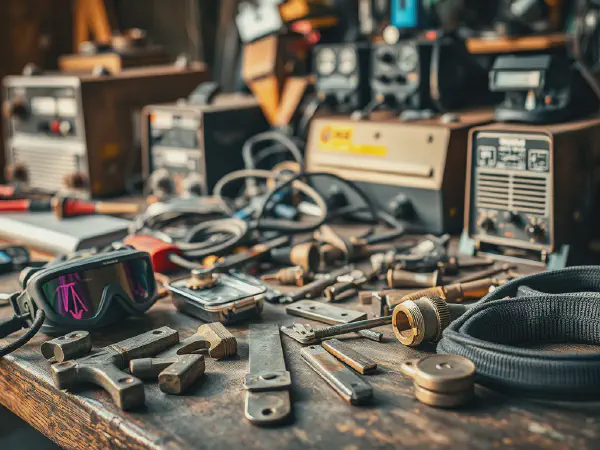Selecting the Ideal Welder for Your DIY Projects

Choosing the Right Welder for Your DIY Needs
Choosing the Right Welder for Your DIY Needs can be a daunting task, especially with the variety of options available in the market today. Whether you're a hobbyist looking to create home projects or a DIY enthusiast aiming for professional results, the right welder can make a significant difference in your outcomes. Welders come in different types, specifications, and price ranges, making it essential to understand what aligns with your specific crafting goals.
When considering Choosing the Right Welder for Your DIY Needs, it's important to assess the type of projects you plan to undertake. Not all welders are created equal; different applications require different welding techniques. Knowing if you will work with thin sheet metal or thicker materials is crucial, as it shapes the kind of welder that would be most effective. Furthermore, understanding the features that different welders offer can greatly enhance your welding experience and efficiency.
Moreover, Choosing the Right Welder for Your DIY Needs not only involves selecting the right machine but also understanding the welding techniques that match your projects. Familiarizing yourself with essential safety practices, basic welding techniques, and the significance of choosing the correct materials will provide you with a comprehensive foundation to refine your skills. Education on various welding symbols can also help you interpret blueprints and project requirements effectively.
As you navigate through the selection process, keep in mind that the welder's specifications—such as amp rating, portability, and energy efficiency—play a vital role in performance. Along with welder performance, investing in the right accessories and tools is equally important for a successful DIY welding experience. Finding a budget that suits your needs while ensuring quality equipment will give you a solid starting point for your welding journey.
In conclusion, Choosing the Right Welder for Your DIY Needs involves a combination of personal project goals, understanding essential welding techniques, evaluating machine specifications, investing in proper accessories, and setting a realistic budget. With careful consideration and planning, you can find the best welder that fits your creative and practical requirements, leading to successful projects and lasting satisfaction.
Types of Welders
MIG Welders are ideal for beginners thanks to their ease of use and versatility. They use a continuous wire feed to create a strong weld, making them perfect for thin materials and quick projects. With minimal setup and a higher speed of operation, MIG welders enable users to tackle various home projects like furniture repairs or automotive repairs, making them a great choice for DIYers.
TIG Welders offer precision welding capabilities, making them suitable for intricate work or thinner materials. With the ability to control the heat and filler metal precisely, TIG welding produces high-quality welds that require minimal finishing. This is ideal for artists or fabricators who need detailed work on stainless steel or aluminum. Understanding how to manipulate the machine is crucial for achieving great results with TIG welding.
Stick Welders are a traditional method that uses an electrode to create heat, suitable for both outdoor and indoor use. They are robust and can handle thicker materials such as steel, making them a reliable choice for structural applications. Stick welding is a good option for those working in changeable environments or those without access to power sources, as it can be done with generators.
Multi-Process Welders combine various welding methods, allowing users to switch between MIG, TIG, and Stick welding with ease. This versatility makes them excellent for DIYers who may require different types of welding for various tasks. Investing in a multi-process welder can save you time and money in the long run, as they offer multiple capabilities in a single machine.
Welding Techniques
Basic Welding Techniques Everyone Should Know include preparing your materials properly, ensuring adequate heat settings, and mastering the right welding speed. Being familiar with these basics can help novice welders achieve better results and avoid common pitfalls that lead to weak seams or poor-quality welds.
Safety Practices in Home Welding are paramount. Always wear appropriate safety gear, including gloves, masks, and protective clothing, to shield yourself from sparks, UV rays, and hot metal. Additionally, ensure proper ventilation in your workspace and be familiar with the operation of your welding equipment to minimize risks during the welding process.
Understanding Welding Symbols and Materials is crucial for interpreting project plans accurately. Welding symbols provide information on how joints should be made, the type of welding processes to use, and the specifications for the materials involved. Familiarizing yourself with these symbols can enhance your ability to translate designs into practical applications.
Common Mistakes in DIY Welding can result from rushing the project or not understanding the materials. Overheating, poor cleanliness, and incorrect settings can lead to disastrous results. Taking your time and ensuring each step is correctly followed will contribute to better project outcomes and greater skill development in the long term.
Welder Specifications
Understanding Amp Rating for Your Projects involves recognizing that the amp rating of a welder indicates the maximum amount of current it can handle. Higher amp ratings allow for welding thicker materials, making it essential to choose a welder that matches your project requirements to avoid performance issues.
Portability vs Power: What to Consider is a dilemma many DIYers face. While portable welders are convenient for home use or on-the-go applications, they may not provide the power necessary for more demanding projects. Evaluating the balance between portability and power is crucial based on your anticipated welding tasks.
Welding Thickness: Choosing the Right Welder depends on the thickness of the materials you plan to work with. Thicker materials generally require a more powerful welder to ensure strong welds. This consideration will play an essential part in the decision-making process when browsing welders.
Energy Efficiency in Welders should not be overlooked. Opting for energy-efficient models can translate into cost savings in the long run. Many modern welders boast energy-saving features that reduce electricity consumption while maintaining performance, making them smart choices for environmentally conscious DIYers.
Accessories and Tools
Essential Tools for a DIY Welder include a welding helmet, gloves, and clamps. Investing in high-quality tools ensures safety and precision in your work. Moreover, having a variety of clamps can assist in holding your pieces securely while you weld, reducing the chances of accidents and enhancing your overall efficiency.
Safety Gear: What You Need to Protect Yourself encompasses not only gloves and helmets but also respirators and protective clothing. These are crucial to safeguard against the hazards of welding fumes and sparks, making it imperative to prioritize your health when selecting equipment.
Welding Helmets: Features to Look For include auto-darkening lenses and a comfortable fit. An auto-darkening helmet adjusts to the brightness of the arc, allowing for better visibility during work and reducing eyestrain. These features contribute to a more pleasant welding experience.
Other Equipment to Enhance Your Welding Experience may include scrap metal bins, work tables, and welding carts. Such tools can streamline your workflow and prevent clutter, allowing you to focus on your projects without distraction.
Budgeting for Welders
Affordability: Cost-Effective Options for DIYers are available in various forms, from entry-level welders to more robust machines at higher price points. Understanding which features are necessary for your specific needs allows you to find a balance between cost and functionality, ensuring you make a sound investment for your welding endeavors.
Investing vs. Budget Models: What's Worth It? is a conversation that many DIYers face. While budget models might save money upfront, they may not deliver the durability or performance needed for more significant projects. Assessing the longevity and the type of projects you plan to undertake will help guide this decision.
Cost Breakdown of Welding Projects includes not only the cost of materials but also the expense associated with gas, electrodes, and other supplies required. Creating a budget that incorporates all necessary items will help you avoid overspending and enable successful project completion.
Hidden Costs in DIY Welding to Be Aware Of might include maintenance, repairs, and replacement parts, which can accumulate over time. Being mindful of these additional expenses when planning your budget ensures that you're better prepared for the financial aspects of your welding projects.
Maintenance and Care of Welders
Routine Checks to Keep Your Welder in Top Shape involve inspecting cables, connectors, and hoses regularly. Keeping your welder clean and free of debris will enhance its performance and longevity, ensuring it remains a reliable tool for all your projects.
Troubleshooting Common Welder Issues will enable you to address minor problems before they escalate. Familiarizing yourself with common issues such as inconsistent arcs, spattering, or wire feed problems can save you time and money by avoiding professional repairs when they arise.
Storage Tips for Longevity of Equipment include keeping your welder in a dry, cool place to prevent rust and deterioration. Proper storage not only prolongs your tools' working life but also ensures your workspace remains organized and safe.
Cleaning Techniques for Different Welder Types can vary. For instance, MIG welders may require a different maintenance routine as compared to TIG welders. Understanding specific cleaning protocols for your equipment type will guarantee optimal functionality and performance over time.
